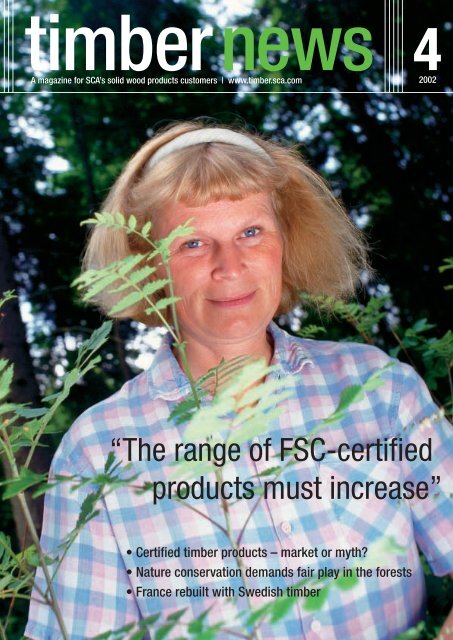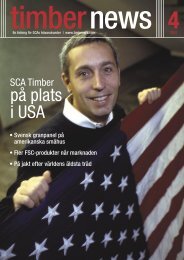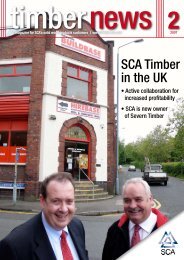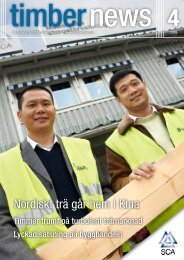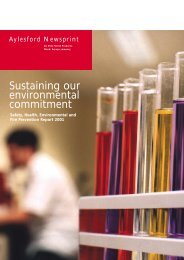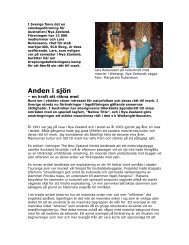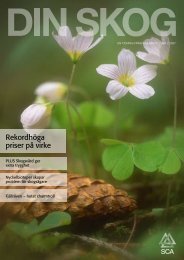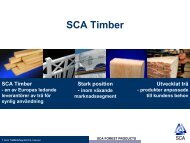TimberNews 4.02-engelsk - SCA Forest Products AB
TimberNews 4.02-engelsk - SCA Forest Products AB
TimberNews 4.02-engelsk - SCA Forest Products AB
Create successful ePaper yourself
Turn your PDF publications into a flip-book with our unique Google optimized e-Paper software.
timbernewsA magazine for <strong>SCA</strong>’s solid wood products customers | www.timber.sca.com42002“The range of FSC-certifiedproducts must increase”• Certified timber products – market or myth?• Nature conservation demands fair play in the forests• France rebuilt with Swedish timber
Give consumers the chanceto choose timber with a clear consciencetimbernewsÅsa Tham, Chairperson FSC InternationalCover photo: Peter KnutsonCertified timber products– market or myth?3Increased use of timber afterwood.for good campaign5The range of FSC-certifiedproducts must increase6A harvestfor the environment8Leading Munksundtowards higher profitability10Reduced diesel consumptionthrough smoother driving11A strong marketfor sawn timber11Swedes still standing in France12<strong>SCA</strong>’s solid wood operations,which include a majority holding inScaninge Timber, now cover sevensawmills and six planing mills. The totalannual volume of solid wood productsamounts to 1.4 million cubic metres.Solid wood operations are included in<strong>SCA</strong>’s <strong>Forest</strong> <strong>Products</strong> business area.<strong>TimberNews</strong> <strong>SCA</strong> <strong>Forest</strong> <strong>Products</strong> <strong>AB</strong>SE-851 88 Sundsvalltel +46 60 19 30 00www.timber.sca.comTimber News is publishedfour times a yearEditor-in-chief Björn LyngfeltProduction Fryklund Reklambyrå <strong>AB</strong>Repro & printing Daus Tryck & Media<strong>Forest</strong>ry is an emotive subject. <strong>Forest</strong>s throughoutthe world have headlined environmental debatesduring the last few decades. In fact, the whalingissue has been pretty much the only thing capableof competing with trees in terms of enticingnew members into the fold of environmentalorganisations and filling campaign coffers.The environmental debate about forestry isfirmly rooted in the disquiet over the fellingof tropical rainforests and the reduction ofwooded areas worldwide. Images of razed patchesof forest in the Amazon region made consumersdoubt the suitability of timber as a material in anycontext. The timber industry did not react quicklyenough to counter these concerns, thus squanderingthe strong argument in favour of timber as anenvironmentally friendly material. Instead, manufacturersof plastic and aluminium received carteblanche to claim that they could offer environmentallyfriendly options. Naturally, they took fulladvantage of the opportunity to ‘save trees’ inwidely pitched campaigns.During the 1980s, the debate concerning forestryand the environment became even more internationaland increasingly targeted at consumers.Environmental organisations demanded thatleading consumer goods manufacturers pressuretheir suppliers into applying more environmentallyfriendly forestry policies.At the same time, there was a good deal ofconfusion about what environmentally friendlyforestry actually involved. Were the problems andsolutions that applied to tropical rainforests equallyapplicable to the pine forests of Scandinavia?<strong>SCA</strong> is the largest private forest owner in Europeand has kept the issue of forestry and the environmentat the top of the agenda for many years. Asearly as 1986, <strong>SCA</strong> made it clear that maintainingbiological diversity was the most highly prioritisedenvironmental target. The habitats of all the floraand fauna in <strong>SCA</strong>’s forests were to be maintained.Since then, <strong>SCA</strong> has developed its forestry techniquesand practices with a view to achieving thisgoal. When the debate was at its most heated atthe beginning of the 1990s, major changes hadalready been made.Björn Lyngfelt<strong>SCA</strong> was quick to become involved in the <strong>Forest</strong>Stewardship Council (FSC) and participated indeveloping the Swedish FSC standard. This processwas in fact unique. It involved <strong>SCA</strong>, other Swedishforestry operators and some of their worst criticsgetting together to decide how responsible forestryshould be defined. The process was naturally farfrom painless, but at the end of it all, the partiesagreed on a compromise and took responsibilityfor it. This was nothing short of a triumph, bothfor forestry and for nature conservation. It alsoprovided a solid platform from which to reassureconsumers of forest products that they were makinga responsible choice and that their misgivingswere unfounded.That is why it is disappointing that complicatedtraceability regulations mean that large areas ofFSC-certified forest produce only a trickle ofFSC-certified products. <strong>SCA</strong> is leading the campaignto simplify these rules so that consumerswith a social conscience have the chance to chooseproducts they can trust. Both forestry operatorsand environmental organisations have done whatthey can to make the FSC dream come true. Letus not miss this opportunity to make certificationa strong argument in favour of timber.Björn LyngfeltPhoto: Torbjörn BergkvistVice President Communications, <strong>SCA</strong> <strong>Forest</strong> <strong>Products</strong>
Much ado aboutnothing?Is there a market for certifiedsustainable timber products oris it a myth? Public focus on theenvironment comes and goesacross the years. Is today’ssituation so different?Like it or loathe it, the word‘sustainability’ is here to stay.With the heated discussion onglobal deforestation came a needfor identifying products fromresponsible managed forests. Theenvironmental movement and theUK timber industry, previouslyat opposite corners of the verbalboxing ring, are working to promotethe products of ‘sustainableforest management’ and therebyensure the long-term viability offorest industry and of life on theplanet.For the first time in the UK, tradeorganisations are incorporating theconcept of purchasing ‘sustainabletimber’ into their published codesof conduct for members. TheTimber Trade Federation’s recentlyproducedcode includes a commitmentfor members to source theirtimber from ‘legal and wellmanagedsources’ and says that itsmembers ‘unreservedly condemnillegal logging practices andcommit themselves to workingtowards their complete elimination’.Martin Fodoris Policy Development Co-ordinator with Bristol City Council’sSustainable City Team:“Our Contract Services Joinery (partof Bristol City Council) has targetsto meet on the use of verifiedresponsible timber with chain ofcustody as there is an establishedcouncil policy on Timber and Wood<strong>Products</strong>. Under its environmentalmanagement system (BCS hasISO 14001) we must continue toincrease the proportion of ourtimber purchased from sustainablesources. We also have to be ableto show an audit trail tracing thetimber ’s origin so for us FSCcertifiedtimber is the best optionto seek and the most trusted.“Finding FSC-certified timbercan be difficult. We find that sometimber merchants can be reluctantto become chain-of-custody certifiedbecause of the cost, but ourgrowing purchasing has meantbusiness switching to those whodo offer FSC. When we do findFSC-certified timber, it’s not alwaysavailable in the quality or dimensionswe’re looking for.“Specifying responsible timberis not the usual matter of saying‘use this type of wood’ - it may meanthinking about different species orsources. Contractors and specifiersare not always used to planningthis far in advance exactly whatthey need and when, and therecan be delays in obtaining FSCmaterials. They may purchase aweek’s worth of joinery materialtogether. In an ideal world wewould like to find a range of FSCtimber available where and whenwe need it, with the quality,dimensions, and at a competitiveprice.”3 | timbernews
Ron Cohenis Managing Director of the STPGroup which produces threequartersof a million timberwindows and doors for the UKmarket per annum.His greatest problem is findingcertified sources of supply whichoffer the particular dimensionsused by his factories’ productionprocesses. “To make it feasiblefor us to undertake FSC chain-ofcustodycertification we wouldneed a guaranteed and continuoussource of FSC-certified materialwhich conforms to our manufacturingneeds. At the momentneither the range of suppliersnor the range of products areavailable to enable us to producecertified products.”Andrew Howarthis Managing Director of one ofthe UK’s major timber players- Howarth (Timber Importers) Ltd:“There is a market for FSCcertifiedproducts but from ourviewpoint it’s not very large. Wehave FSC chain-of-custody certificationbut unfortunately it is sorelyunder-used. We do receive requestsfor FSC-certified material but it’susually at the behest of the enduser of the product. An examplewould be when we’re asked toprovide timber to a manufacturerproducing items for one of thelarge DIY companies. In the pastthere have been supply problemsin getting hold of certified timber.With the emergence of the PanEuropean <strong>Forest</strong> Certificationscheme (PEFC) the availability oftimber which carries an environmentalsustainability certificatehas obviously increased, thoughwe’re aware that chain of custodycan be an issue.”The British Woodworking Federation,representing £1080 million(55%) of the UK’s annual joinerysales, also includes sustainabletimber purchasing in its membershipcode. By the end of 2004, alltimber used in BWF AccreditedTimber Windows must also befrom certified sustainable sources.The timber window market in theUK alone was worth £255 millionlast year, with three million unitsbeing produced. Timber windowsrepresent just one area in whichthere has been co-operation betweenindustry and environmentalists.Greenpeace UK’s campaignagainst the toxic waste producedby the manufacture and abandonmentof PVC-u windows hasemphasised the benefits of windowsmade from sustainabletimber.Government, local and national,is also becoming more aware oftimber ’s qualities as a sustainablematerial. The UK Government’sGreen Procurement policies specifythat timber should comefrom sustainable sources and thatdocumentary evidence of the sourcingchain should be provided.Central government though stillhas a long way to go, with onlyseven of the 21 British governmentdepartments able to reporton the status of their certified sustainabletimber purchasing lastyear. Beck Woodrow, in charge ofFSC-UK’s Sustainable Constructioninitiative, comments: “Thegreatest problems are lack ofknowledge of what constitutes‘sustainable timber ’ and the difficultyin verifying timber sources asbeing sustainable or well-managed.FSC certification addresses boththese problems, by tracking timberback to its source. Its Chain ofCustody system provides assurancethat the material originatesin responsibly managed forests.We are working with WWF to getthe message across to the rightquarters in the public sector, andacross the construction industry asa whole. I believe we’re makingprogress.”In local government, the understandingof sustainable procurementissues is higher, partlybecause of the implementationof Local Agenda 21 plans, andpartly because of the gradualspread of environmental managementsystems, similar to thoseused in many private and publiccompanies in the UK. There areover 450 local authorities, rangingfrom councils responsible for largecities to small district councils. Inthose where environmental managementsystems demand continuousimprovements againsttargets, the need to purchasetimber with a creditable audittrail right back to the forest isparamount.Some councils have studied forestcertification systems in depth andhave publicly stated that until asystem with a similar audit trailand similar environmental credentialsis in existence, their councilwill only purchase timber productswhich are FSC-certified. City anddistrict councils between themrepair and maintain millions ofbuildings requiring timber forboth structural and joinery purposes.One of the smaller localdistrict councils recently interviewedby <strong>SCA</strong> Timber UK had anew-build budget of £85 millionthis year, and for one projectalone required £1 million worthof FSC-certified timber rangingfrom structural components tojoinery timber, and includinghundreds of timber doors andwindows.For the last seven years, theWWF 95+ Group has been growingin size and strength. This groupingof purchasers, with buying interestsranging from paper to timberand operations spanning retailingto manufacturing, now includessome of the UK’s most famouscorporate names. Builders LaingHomes, Bovis and Balfour Beattyare members, as are Boots, the BodyShop, Tesco and Sainsbury’s.Timber users such as Magnet,Richard Burbidge and F W Masontimbernews | 4
& Sons, the big DIY retailers, andbuilders’ and timber merchantchains are members of the WWF95+ Group. All these companiesare seeking FSC-certified timberand timber products. Their combinedbuying power in the sectoris over £3.3 Billion.Yet despite this, within the UKtimber trade itself, rumour persiststhat FSC-certified timber and certifiedproducts are ‘not in demand’.Despite too the wide range ofoptions and costs now availablefor taking up FSC certification,companies along the timber valuechain still remain unconvincedthat the effort is worthwhile. Inthe meantime, their reticence ishanding a competitive benefit tothose keener to seek out new sales.Camilla HairRichard Lambertis Director of the British Woodworking Federation, which representsa large portion of the joinery industry:“We’ve become very much awarethat ‘sustainability’ is gettinghigher on specifiers’ agendas. Toensure our members are able tomeet this business opportunitywe have adopted a clause in ourCode of Conduct which obligesmembers to use their best endeavoursto obtain timber from legaland well-managed sources.“As some of our members usehardwoods in architectural joinerywork – and certified sustainablehardwoods are in very short supply- we must continue to promotesustainable timber usage but withina workable business context. OurTimber Windows AccreditationScheme Members have made acommitment that by the end of2004, all timber used in BWFaccredited windows bearing itslabel will come from independentlycertified sustainable sources.“We feel both of these moveswill enable buyers of our members’products and services to haveconfidence in their environmentalcredentials.”Greatest marketing campaign everIn order to increase demand fortimber products and to combatcompetition from substitute materials,the Nordic Timber Counciland the Nordic wood industry– including <strong>SCA</strong> – have taken theinitiative to promote timber onthe British market.The nordic parties joined forceswith British industries and retailersin the campaign wood.for good.The aim of the campaign is toincrease the use of sawn pine productson the British market by 20per cent (or 1.8 million cubicmetres) in three years. The intentionis also to change attitudes totimber amongst architects, buildersand consumers. The long-termaim is consumption in excess of12 million cubic metres of sawnpine. Wood.for good is the greatestmarketing campaign so far fortimber products in UK.A survey conducted by Jakko PöyryConsulting shows that thus far,wood.for good has attracted attentionand recognition, and that sectorrepresentatives consider that it willcontribute to an increase in the useof timber. The report highlightsan increase in the sales of timberproducts.Consumption of sawn pine productsin Great Britain increasedby almost 200,000 cubic metresfrom 2000 to 2001. This figure isexpected to increase by a further400,000 cubic metres in 2002.At the same time, the reportclearly shows that the campaignhas had a positive effect on themarket shares of the Nordic sawntimber suppliers in the UK.5 | timbernews
The Chairperson of FSC International:“The range of FSC-certifiedproducts must increase”“It is very worrying to note that the large andgrowing areas of FSC-certified forest are onlyproducing very modest volumes of FSC-certifiedproducts. This is an issue we have to address,and I have high hopes of seeing positivedevelopment after the FSC General Assemblyin November.”FSC-certified timberproducts from <strong>SCA</strong>Much of the raw materialused at <strong>SCA</strong> sawmillsstems from <strong>SCA</strong>’s largeareas of forest that wereFSC-certified in 1999.• <strong>SCA</strong> offers a wide rangeof FSC-certified pineproducts (70% FSCtimber).• The range of spruceproducts is more limitedand requires separateagreements from caseto case.• <strong>SCA</strong> Timber UK offersBritish customers regulardeliveries of FSC-certifiedpine from the GroveWharf warehouse.So says Åsa Tham, Chairpersonof FSC International,Manager for the VästeråsDiocese forests, and the personresponsible for managing the FSCcertifiedforests owned by theSwedish church in Central Sweden.“The <strong>Forest</strong> Stewardship Councilis unique,” says Åsa Tham, whowas elected chairperson in Marchthis year. “It is a platform for dialoguebetween parties who mostoften have very different interests– environmental groups, forestowners, industrial players and soon. FSC builds on the concept ofthese parties reaching a commonopinion and taking responsibilityfor it.”FSC, which was founded in 1993,works for the development ofenvironmentally responsible, economicallyviable and socially beneficialforestry throughout the world.FSC has laid down a number ofprinciples and criteria for responsibleforestry. These are subsequentlydeveloped into nationally or regionallyadapted standards in aprocess that allows all stakeholdersto be heard. The first national FSCstandard was developed in Swedenin 1998. Today, approximately 30million hectares in 56 countries areFSC-certified.Åsa Tham has been Chairperson of FSC International for over six months. Åsa isaslo the Manager for the Västerås Diocese forests.<strong>Forest</strong> owners can receive FSCcertification by allowing an FSCcertified auditor to check that theforest is being managed in linewith FSC criteria. Timber fromFSC-certified forests can subsequentlybe used to manufactureFSC-certified products. In this case,the whole chain – from forest tofinished product – must be checkedby an independent auditor.“Many people see FSC Internationaland those of us on the Boardas some kind of court that passesjudgement on how forestry is to bePhoto: Peter Knutsoncarried out,” says Åsa Tham. “However,the whole point is to allowall the local stakeholders to cometo a mutually satisfying agreement.All we do is check that FSC’s fundamentalprinciples and criteria havebeen met. For example, these donot state that no chemical substancesmay be used in forestryprocesses. We have no objection ifthe parties, as in Germany, agreethat the national standard is toinclude chemical-free forestry, butsuch a move on the part of onecountry does not mean that fores-timbernews | 6
ters in other countries have tofollow suit in order to achieveFSC certification.”<strong>SCA</strong>’s forests received FSC certificationin 1999 and today, <strong>SCA</strong>produces FSC-certified timberproducts, pulp and printing paper.The FSC regulations for productcertification are complicated andeven companies with as muchforest and such a high level ofself-sufficiency as <strong>SCA</strong> can onlymanufacture limited volumes ofFSC-certified products.“FSC is a young organisationand is made up of parties thatare not used to working witheach other,” explains Åsa Tham.“The first set of regulations thereforeincluded a number of rulesintended to guarantee fulfilmentof the original intentions. Today,we have more experience of theworking relationship and share astrong interest in ensuring thatmore FSC-products actually reachthe market.”“If FSC is to have an effect, thena competitive advantage must belinked to dealing in products madeof timber from responsibly managedforests. I can see that there isa good deal of support from manysources for simplifying the regulationsto allow the volume ofFSC-certified products to increase.The traceability rules will bediscussed at the FSC GeneralAssembly at the end of November.”Personally, Åsa Tham is mostworried by the fact that manythird world countries see FSC asa trade barrier.“One of the greatest drivingforces behind the establishmentof FSC was concern about thedestruction of the tropical rainforests.This led many people toboycott timber from the tropics.FSC was intended to provide aguarantee for consumers that thetimber used in the products stemmedfrom responsibly managedforests – thus opening the doorfor third world countries to enterthe markets of the West. Responsibleforestry is, of course, moreexpensive than irresponsible forestry,and people in third worldcountries can see how many Westerncountries, companies andforest owners decline to work withFSC, choosing a less demandingsystem instead. Understandably,this leads them to believe that themarkets of the West make higherdemands on imported timber thanon timber from domestic sources.”“This is a factor that stakeholdersin the West who would like to setthe bar for certified forestry ashigh as possible should take intoaccount. If the demands are sostringent that they scare off forestowners, it will counteract the wholepurpose of FSC – better forestrythroughout the world.”Björn LyngfeltLaminated timberlures the JapaneseIn Japan, laminated timber forconstruction is gainingmarket share as supportingelements in traditionalJapanese houses.This applies toboth pine and spruce.In the field of supportingposts, laminatedtimber nowholds around 70per cent of themarket – comparedto just 10 per centeight years ago.Development has nowalso picked up speed in horizontalbeams. Today, laminated timberbeams command a market shareof around 30 per cent.The increased demand for laminatedproducts is benefiting Scandinaviantimber companies andsawmills. Japanese buyers particularlyappreciate the dense, homogenousfibre in the products, whilebuilders and other end-users considerthe products to be stableand of high quality, particularywhen looking at drying leveland delivery reliability.<strong>SCA</strong> supplies around 30,000 m 2of wood products per year to theJapanese laminated timber industry.Home Depot increases business with Rundvik sawmillHome Depot in the United Statesis increasing its orders forproducts from Rundvik sawmill.Home Depot is aiming to increasevolume by 150 per cent over thenext two years.“In my opinion, our success isbased on both our products andthe service we offer,” says BirgittaBoström, Product Manager atRundvik sawmill. “We run dedicatedinventory in a separate warehousein Philadelphia for furtherdistribution to Home Depot storesin the United States. We have anexcellent logistics system and goodpartners across the water.”In order to increase the volumefor the United States, Rundvik sawmillis now working to raise theefficiency of the entire productionand logistics chain. In addition, anew packing line in the planingdepartment will become fully operationalin December. The suppliesfrom Rundvik are supplementedby sawn timber from other <strong>SCA</strong>sawmills and a few external manufacturers.At the same time, Rundvik isaltering its product range to accommodatethe Japanese market inthe quest for a more regular andsecure order flow. In this case, theemphasis is on fewer but moreuniform products.7 | timbernews
A harvestfor the environmentSince winter 1999, <strong>SCA</strong> has beenenvironmentally certified in linewith the Swedish FSC standard.This means that <strong>SCA</strong> operatesdocumented environmentallyfriendly, socially useful andeconomically viable forestry. Forexample, this means that theindividual machine operatorsshow greater consideration forold trees, rare species and wetlands.In Åkroken, south of Sollefteå,Sweden, the 100-year-old pinetrees rise like ship’s masts fromthe dry sandy ridges created by theinland glaciers. Blackened stumpsstick up from the thick undergrowthhere and there, probablyremnants from 1888 – the year ofthe great fire.The fresh fall of snow, whichcovers moose tracks and moss,makes the day seem a little brighter.This delightful forest, which islocated very close to the naturereserve in the virgin forest of Vällingsjö,is now scheduled for felling.The timber from the forest isdestined for the <strong>SCA</strong> sawmill inBollstabruk.Had this been 1982 instead of2002, Paul Källgren, the machineoperator, would almost certainlyIn line with the FSC standard, there arerules on how thinning and felling arecarried out to promote biodiversity. Forexample, high stumps are saved or newones created by capping certain treesat a height of a few metres, to becomenests for woodpeckers and owls.Photo: Bo Fernströmtimbernews | 8
have blazed through the 25-hectarefelling area with his harvester attop speed. Not a single tree wouldhave been spared.“But now there are more considerationsto be made when you arefelling,” says Paul. “On the otherhand, the area will look much lessdesolate when we have finished.”It was consumer concern aboutthe effects of forestry on the environmentthat led to the establishmentof the <strong>Forest</strong> StewardshipCouncil, FSC.“FSC was initiated on the basisof the fact that consumers werelooking for a guarantee that theproducts they bought came fromresponsibly managed forests,”explains Per Simonsson, <strong>SCA</strong>’sforest ecologist.FSC’s principles and criteria applythroughout the world, althougheach country has been allowedto adapt them to create its ownnational standard. The nationalstandard in Sweden was adoptedin 1998, and from its certificationin January 1999, <strong>SCA</strong> took up itsobligation to abide by the applicableguidelines.This means, for example, that<strong>SCA</strong> should burn five per cent ofthe regeneration area every yearand has to leave five per cent ofthe productive forest idle to protectbiologically valuable habitats.In addition, there are rules onhow thinning and felling are carriedout to promote biodiversity.“The requirements have beendetailed and written into our instructionsfor machine operators,”explains Per Simonsson.At the felling site in Åkroken, thesawn timber is stacked betweenthe remaining seed trees and snags.The truck picks up load afterload of fresh logs and carries themto the log piles by the road. Fromthe harvester comes the continuoussound of the saw chain, then thecrash of a falling tree.According to Per Simonsson,the FSC certification has notresulted in any major changesfrom the nature protection plansimplemented by <strong>SCA</strong> earlier inthe 1990s. The biggest differencewas the increase in thoroughnesswhen specifying the list ofrequirements.The instruction book contains along and detailed list of how themachine operators are to demonstratecare for the environment.For example, no treeless area isto be bigger than three hectares,and what are known as natureconservation trees (tall and thickpines and aspens) are to be saved,as is all dead timber.In addition, special care is takenwith care demanding species, andbuffer zones are left around wetlands,lakes and streams. Moreover,felling in ravines and on steepmountain slopes is avoided.Hollow and windfallen treesare also left alone, and all highstumps are spared or new onescreated by capping some trees ata height of a few metres. The guidelineis 2–5 high stumps per hectare.“These are measures that involve<strong>SCA</strong> voluntarily reducing its fellingby 10 per cent, which is equivalentto around SEK 80 millionin ungenerated income every year,”explains Per Simonson and headsoff towards a hillock to mark offa group of trees surrounding ahigh stump.For Paul Källgren and his colleagues,the arrival of FSC-certificationhas meant more fair play in theforest.In addition to the seed trees thatremain in the Åkroken clearing,there are also tall trees, old trees,dry trees, fallen trees, fire-damagedtrees and hollow trees. All mustbe avoided in the felling process.This also applies to groups of treesaround wetlands and streams.Finally, the work must beplanned to prevent unnecessarydamage from driving.“We now have to pay more attentionto where we are driving andwhich trees we are felling,” concludesPaul. “On the other handit is much more fun to work whenyou can take more responsibilityand demonstrate more care forthe environment.”The arrival of FSC-certification has meant that machine operatorsout in the forest have to take more care. For example, fallen trees– like the one in the foreground – should be left alone.Per Simonsson notices a thick oldpine tree lying on the ground. “Itshouldn’t be there, it shouldn’thave been felled at all,” he mutters.All Paul Källgren can do is shrughis shoulders and admit the error.“What can I say … sometimeswe miss something. A combinationof darkness, difficult terrain anda fast pace sometimes results inmistakes.” However, the aim isto eradicate incorrect decisionscompletely, which is a goal thathas Per Simonsson’s full support.“There is always room forimprovement,” he says. “Environmentalcare is integrated intoeverything we do in the forest.”Mats WigardtPhoto: Bo Fernström9 | timbernews
Leading Munksundtowards higher profitabilitySince March this year, Anders Petersson,the 35-year-old forester from Örnsköldsvik,has been Product Manager at the <strong>SCA</strong> sawmillin Munksund. He joined the companyfrom a similar position at the Stora Ensosawmill in Kopparfors.How would you describe your newworkplace?“Munksund is a remarkably modernsawmill that has undergone veryrapid development during a shortperiod of time.”What are your principal tasks?“I am responsible for sales and itis also my job to try to direct theplant towards profitable productsand markets.”At the moment, what are your mostimportant markets?“We are concentrating heavily onScandinavia and are also active inthe UK, Italy, Japan and Morocco.“What can you tell us about thedifferent markets?“In Scandinavia, we are targetingmajor industrial customers. TheUK market has increased dramatically,and in Italy we have beenincreasingly focusing on windowmanufacturers in recent years.In Japan properties of Nordicpine are highly valued, but thedimensions required there arevery different from those we areused to delivering. That meanswe must be flexible. We believethat the Japanese market hasgreat potential and we shouldreinforce our presence there.”Are there any other markets youwould like to penetrate?“We are not planning any radicalchanges at the moment. However,we may be supplementing internationalactivity with some othermarkets such as South-east Asiaand the United States. We also aimto restructure volumes withinexisting markets.”Munksund saws pine productsexclusively. Has this any particulareffect?“It simplifies production, storageand timber flow. It is also easierto focus on the products when youwork with a single type of timber.”Talking of products, where does thesawn pine from Munksund end up?“The North-Swedish pine is ideal forwindows and furniture. However,the North-Swedish pine is alsosuitable for pine board for the DIYtrade and flooring manufacture.”All <strong>SCA</strong> sawmills are now independentprofit centres. What is theworking relationship like betweenthe separate mills?“Good, I think. Especially since <strong>SCA</strong>and Scaninge sawmills started towork more closely with each other.I have regular contact with ourpine sawmills in Bollsta and Holmsund.We discuss mutual issuesopenly and help each other whenevernecessary.”What about the future of Munksund?“In order to make full use of thecapacity of the new grading mill,we are considering investing innew technology that will make itpossible to sort selected qualitiesat an early stage and kiln appropriateproducts. A new planningsystem should also make it easierto plan production and deliveries.”Anders Petersson, Product Manager atMunksund sawmill with his two Pointers,Taiga and Dalwhinnie.Photo: Per PetterssonFinally, what do you want from theapproaching winter?“Plenty of snow so that I can goskiing in the mountains and gohunting with my two Pointers.”Mats Wigardttimbernews | 10
Reduced diesel consumptionthrough smoother drivingLower costs and reduced emissionsof CO 2into the air. Thesewill be the results when theHGV drivers who drive for <strong>SCA</strong>are trained in Heavy Eco Driving.Heavy Eco Driving is a course onwhich drivers learn a drivingstyle that lowers fuel consumptionin their vehicles. The aim is forall 150 drivers employed by thehauliers to complete the course.One of the drivers who hasalready completed the trainingfound that he could cut fuel consumptionby 10 per cent – whichtranslated into savings of SEK45,000 a year. For all the vehiclesthat drive for <strong>SCA</strong> in Mid-Norrlandin the north of Sweden, this couldcorrespond to a total reduction ofHeavy Eco Driving is a driving style that reduces both fuel costs and CO 2emissions.400,000 litres of fuel per year. Thisin turn will cut annual CO 2emissionsby 1,000 tons.A smoother driving style alsomeans less wear on brakes, tyresetc. In addition, it improves thedrivers’ well-being, helping themto drive more safely in traffic.Photo: Herman Sundqvist/NorrlandiaA strong market for sawn timberThe market for timber products isvery strong on account of a perceivedsupply shortage. Stocks atthe Scandinavian sawmills are low,and the shortage of saw logs is holdingback the production of spruce productsin Northern Sweden.Consumption is stable, even thoughan increasing number of Europeanmarkets are showing signs of adecline in construction. Nevertheless,the European sawmills haveexported increasing volumes tomarkets over seas why the Europeandevelopment has not yethad a negative effect on marketconditions.Production in Sweden remainshigh, while in Finland it is nowincreasing rapidly.For the period January–September,production in Swedenincreased by 4 per cent (pine +6%,spruce +3%). The Finnish figurefor January–October is +3 per cent(pine +5%, spruce +2%). In fact,Finland achieved record productionin October.The stocks at the sawmills are athistorically low levels. On onlyone occasion in the last ten yearshave stocks of pine at the Scandinaviansawmills been lower. Stocksof spruce are also well below lastyear ’s levels.Sales figures are well up. At theend of September, orders inSweden were up 9 per cent comparedto 2001, while at the end ofOctober, orders in Finland were5 per cent higher than last year.A comparison of the developmentin production, consumption andsales explains the apparent shortageof wood. At the same time,it is clear that a market built upon supply shortage is not as strongas one built up on increased productconsumption. It is generallysimpler to increase productionthan to find good sales outletsfor the products.Anders EkMarketing Manager11 | timbernews
Swedes still standingin FranceThey are known as ‘the Swedes’: 400 timber housesthat came as a gift from heaven to a battered Normandyafter the end of World War II; 11,200 cubicmetres of Swedish timber that built peace, andchanged opinions about housing.Christmas and New Year 1945,more than a year after D-Dayand the most comprehensiveamphibious landing operationin history. Normandy was free ...but in ruins. The Allied bombardmenthad flattened almost everyhouse in and around the Frenchcity of Caen. The people wereliving in hovels.Victor Vinde, a Swedish journalist,wrote a series of articlesabout the wretched conditions ofthe population. His reports shookSweden. Save the Children, theSwedish timber industry andSwedish carpenters joined forcesto help the needy. Prince Bertil ledthe aid initiative, the evidence ofwhich is still visible in Normandyto this day. Boat after boat sailedfrom Sweden carrying 400 semifabricatedhomes, nurseries andeven a church to Caen.Jacques Munerel wasjust one year old whenhe moved into thehouse where he stilllives, half a centurylater. His parents toldhim how the timberhouses were received:“People were sceptical about thetimber houses. Living in timberhouses was, at best, somethingreserved for monkeys. But whenthe houses were finished, peoplequickly saw that they were reallyluxurious – du Grand Luxe,” relatesJacques Munerel.The timber houses had WCs,bathrooms and washing rooms.In France, Caen has always beenJacques Munerel and his partner Carol Pitrou, rue de Suède.famous for its special limestone,which is called la pierre de Caen.However, the locals soon realisedthat the Swedish timber hadremarkable properties as regardsdurability and insulation. In addition,they were amazed at thespeed with which the Swedishconstruction workers built thehouses.To complete the picture, theSwedish workers even plantedspruce trees alongside the broadstreets in the different residentialareas. To this day, the streets havenames such as rue de Suède, rue deSandviken and rue de Kiruna. Thewarmth and gratitude still remain,one and even two generations later.Jacques Mourier, 47, who liveson rue de Stockholm, principallyappreciates the flexibility of ‘theSwedes’.“When I took over my parents’house, I wanted to make somemajor changes, and it was simpleas anything to move the timberwalls. When they come to visit,my friends gape in amazement,”he says proudly. Jacques Mouriersays that his children are now bigenough to get married and buildtheir own houses. And guess whatmaterial they are using …Magnus FalkehedPhoto: Magnus Falkehed


